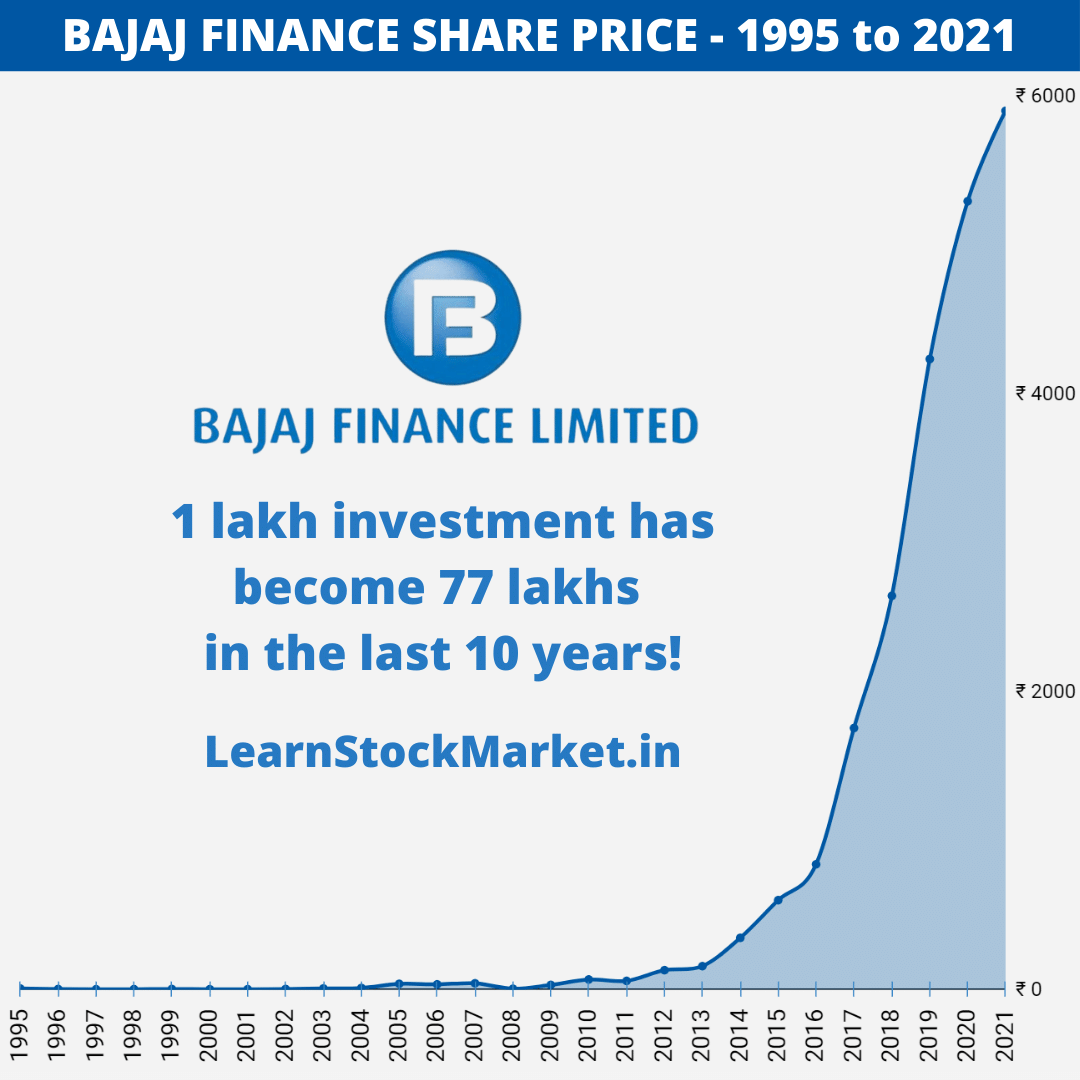Buy now, pay later. Bajaj Finance has given people the convenience of buying things they want, without paying anything upfront.
Want to buy a mobile phone costing ₹ 60,000 rupees? No problem, get the phone now. Pay in easy monthly installments of ₹ 5000 per month for the next 12 months.
The seller gets more customers. The customer is happy to buy something he desires, but cannot afford to pay immediately.
Bajaj Finance makes the entire process so simple, that Indians have made it a habit of buying what they want quickly and easily.
This ease has ensured massive growth in business in the last 10 years. The shareholders have reaped the rewards.
The share price has gone up by more than 77 times in the last 10 years!
Let’s check out the journey of Bajaj Finance share price through the years. From the time it was a lesser-known company to a behemoth it has become today.
Bajaj Finance Share Price

| Bajaj Finance | Share Price | Rise / Fall |
| 1995 Share Price | ₹ 7.6 | |
| 1996 Share Price | ₹ 4.2 | -44.7% |
| 1997 Share Price | ₹ 2.9 | -30.9% |
| 1998 Share Price | ₹ 3.1 | 6.9% |
| 1999 Share Price | ₹ 4.2 | 35.5% |
| 2000 Share Price | ₹ 2.7 | -35.7% |
| 2001 Share Price | ₹ 3 | 11.1% |
| 2002 Share Price | ₹ 4.3 | 43.3% |
| 2003 Share Price | ₹ 8.3 | 93% |
| 2004 Share Price | ₹ 11.5 | 38.6% |
| 2005 Share Price | ₹ 39.2 | 240.9% |
| 2006 Share Price | ₹ 35.6 | -9.2% |
| 2007 Share Price | ₹ 42.7 | 19.9% |
| 2008 Share Price | ₹ 6.2 | -85.5% |
| 2009 Share Price | ₹ 32 | 416% |
| 2010 Share Price | ₹ 68.4 | 114% |
| 2011 Share Price | ₹ 59 | -13.7% |
| 2012 Share Price | ₹ 131 | 122% |
| 2013 Share Price | ₹ 158 | 20.6% |
| 2014 Share Price | ₹ 348 | 120% |
| 2015 Share Price | ₹ 601 | 72.7% |
| 2016 Share Price | ₹ 842 | 40.1% |
| 2017 Share Price | ₹ 1757 | 109% |
| 2018 Share Price | ₹ 2645 | 50.5% |
| 2019 Share Price | ₹ 4235 | 60.1% |
| 2020 Share Price | ₹ 5295 | 25% |
| 2021 Share Price | ₹ 5902 | 11.5% |
That’s a glorious chart, isn’t it? The rise of the company and along with it the share price has been staggering after the stock market crash in 2008.
Back in January 2008, the share price of Bajaj Finance peaked at ₹ 54 per share. A year later in March 2009, after the global financial crisis, the stock price crashed to a low of ₹ 4.4 per share.
That’s a crash of more than 90% from the highs.
In other words, if you had invested ₹ 1 lakh in Bajaj Finance back in January 2008, the value of your shares would’ve crashed down to ₹ 8200.
Pause for a moment and think how painful it must have been for investors to see such extreme crashes. This can happen in the stock market.
However, if they had held-on to their shares, the value today in the year 2021 would be more than ₹ 1.05 crore! And yes, this too can happen in the stock market.
You would never know which stocks would give you that 50-100x. But you only need one or two such companies in your lifetime.
If you invest time into learning about the stock market and pick 15-20 quality stocks, who knows, one of them could do a Bajaj Finance in the future.
Note: The Bajaj Finance share prices mentioned above has been adjusted for share split and share bonus. Back in September 2016, the shares were split 1:5 and bonus shares of 1:1 was also issued. Each shareholder who had 1 share of Bajaj Finance got 10 shares. The share price was also adjusted.
Bajaj Finance Share Returns
How much returns has Bajaj Finance given in the last 2 years? What about 3, 5, 10, 20 years?
Check out the table below:
| CAGR | Absolute | |
| 1 year | 25.02% | 1.25 times |
| 2 years | 41.48% | 2.00 times |
| 3 years | 44.44% | 3.01 times |
| 4 years | 58.35% | 6.29 times |
| 5 years | 54.52% | 8.81 times |
| 10 years | 54.57% | 77.4 times |
| 15 years | 38.73% | 135 times |
| 20 years | 46.09% | 1961 times |
| 25 years | 29.93% | 697 times |
One thing is absolutely clear from the table above. It did not matter when you invested in Bajaj Finance, it has given you ‘market beating’ returns.
The returns from Bajaj Finance has consistently beaten major indices like ‘Sensex’, ‘Nifty 50’ and also outperformed the mid and small cap index.
It wouldn’t be surprising if Bajaj Finance ranks very high in the Top 10 list of best performing stocks in the last 10 year period.
Next…
1 Lakh invested in Bajaj Finance
If you had invested 1 lakh in ‘Bajaj Finance’, how much returns has it given over different time periods?
The table below has the figures:
| 1 Lakh Invested | |
| 1 year | 1.25 lakhs |
| 2 years | 2.00 lakhs |
| 3 years | 3.01 lakhs |
| 4 years | 6.29 lakhs |
| 5 years | 8.81 lakhs |
| 10 years | 77.4 lakhs |
| 15 years | 1.35 crore |
| 20 years | 19.61 crore |
| 25 years | 6.97 crore |
If you had invested 1 lakh in Bajaj Finance, 10 years ago, it would be 77.4 lakhs today. That’s right. More than 77 times in the last 10 years. And this does not include dividends.
If you were lucky enough to have invested in Bajaj Finance 20 years ago, and stayed invested throughout – every single rupee invested in the company would be 1961 times!
During this 20 year period, the stock has crashed more than 90% in 2008.
These are crazy and hard-to-believe numbers, but they are accurate.
Bajaj Finance Shares vs FD Returns
What if you opened a fixed deposit of 1 lakh in a bank and made another investment of 1 lakh in Bajaj Finance Shares. Let’s assume both investments were made in the year 2010 (i.e. 10 years ago).
The results are below.
| Fixed Deposit | Bajaj Finance | |
| 2010 | 1,00,000 | 1,00,000 |
| 2011 | 1,09,130 | 86,257 |
| 2012 | 1,18,821 | 1,91,520 |
| 2013 | 1,29,515 | 2,30,994 |
| 2014 | 1,40,692 | 5,08,772 |
| 2015 | 1,51,075 | 8,78,655 |
| 2016 | 1,61,469 | 12,30,994 |
| 2017 | 1,72,093 | 25,68,713 |
| 2018 | 1,83,710 | 38,66,959 |
| 2019 | 1,93,997 | 61,91,520 |
| 2020 | 2,04,027 | 77,41,228 |
| Returns | 7.39% | 54.48% |
Note: FD interest rates have been adjusted each year, as per data taken from Reserve Bank of India. The average FD rate over last 10 years has been around 7.4%. It’s lower at the time of writing this article, but it was higher in 2010.

- That blue line at the bottom there is the 7.4% returns from fixed deposits!
- What’s interesting is, in the second year, Bajaj Finance would have been in 13% loss whereas FD would be in 8% gain.
- Many new investors start panicking when they see that the value of their investment has gone down.
- They do not like to sell in loss, but one of the biggest mistakes most new investors do is – sell immediately after a share gets back to their investment price.
- For example, let’s say a new investor came into the market back in 2010 and bought shares at an average price of ₹ 70. A year later, the value fell below ₹ 60. When the stock returns to its investment price of ₹ 70 and starts going higher, the investors begins to think of booking profit – worrying that the price might go down again.
- This results in selling quality companies like Bajaj Finance for a small profit. When the stock price continues to rise, the investor cannot think of buying the same company in 2012 – when the share price had doubled from 60 to 130.
- Couple of lessons here – never sell a good company for a small profit, learn to ride and hold stocks for longer periods of time.
- Secondly, learn more about the company. If the business has potential to grow in the future, buy it again or buy more.
- In most cases, the best new investment opportunity could be in the company you already own in your portfolio. Don’t constantly keep looking for new companies, when you already have quality companies in your own portfolio.
- If you have 10 shares of Bajaj Finance, think of buying the 11th share instead of looking for new company to invest in.
- Back to the FD vs Bajaj Finance chart above, after the 2nd year of investment – it has been one way movement as Bajaj Finance has given phenomenal returns.
- When a company performs so well and gives such high returns, the biggest question in an investors mind is – when to book profit.
- There is a simple solution to this. Decide on what is the maximum allocation you want to give to a single company. If you set to limit to 10%, then as soon as Bajaj Finance crosses the limit of 10% – sell some shares and bring the allocation back to 10%
- This way you will not regret selling and you will also keep taking profits. Soon you could end up having only free shares of Bajaj Finance in the portfolio.
- Do note, the entire article is for educational purposes only. We do not give stock recommendations. Contact your financial advisor before you invest in any company. Past performance does not guarantee future returns.

Leave a Comment